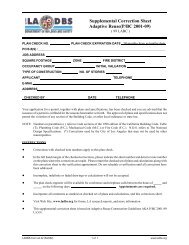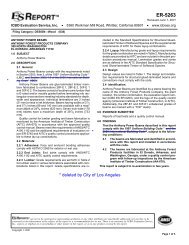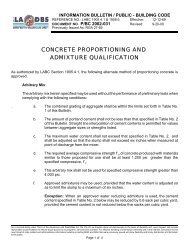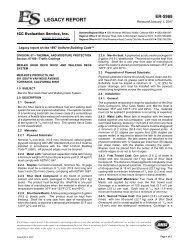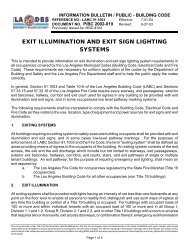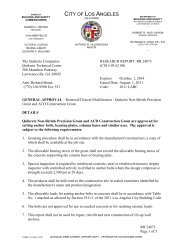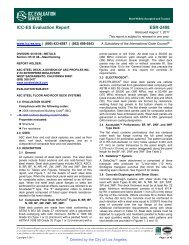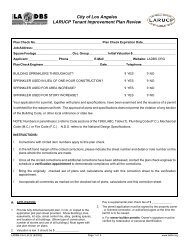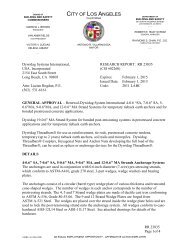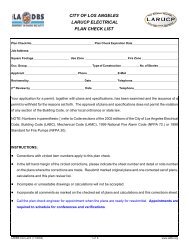Steel Frame Design - ladbs
Steel Frame Design - ladbs
Steel Frame Design - ladbs
- No tags were found...
You also want an ePaper? Increase the reach of your titles
YUMPU automatically turns print PDFs into web optimized ePapers that Google loves.
Supplemental Structural Correction Sheet<strong>Steel</strong> <strong>Frame</strong> <strong>Design</strong>( 99 LABC )Plan Check No.Checked by:PLAN DETAILSA. GENERAL9 1. Column splices shall not be located within 4 feet nor one-half the column clear height ofbeam-to-column connections, whichever is less. AISC I-8.3a ~9 2. Beveled transitions are not required when changes in thickness and width of flanges andwebs occur in column splices. AISC I-8.3b. ~A. SPECIAL MOMENT- RESISTING FRAMES (SMRF)9 1. The individual thicknesses of column webs and doubler plates, if used, shall not be lessthan that specified in AISC I-9.3b. ~9 2. Doubler plates shall be welded to the column flanges using either a complete-jointpenetrationgroove-welded or fillet-welded joint that develops the design shear strength ofthe full doubler plate thickness. AISC I-9.3c ~9 3. Continuity plates shall be provided to match the tested connection. AISC I-9.5 ~9 4. For restrained connections, column flanges at beam-to-column connections require lateralsupport only at the level of the top flanges of the beams when a column is shown toremain elastic outside of the panel-zone. AISC I-9.7a(1) ~A. ORDINARY MOMENT- RESISTING FRAMES (OMRF)9 1. Partial-joint-penetration groove welds and fillet welds shall not be used to resist tensileforces in the connections.~9 2. When fully restrained moment connections are made by means of welds of beam flangesor beam-flange connection plates directly to column flanges, continuity plates shall beprovided to transmit beam flange forces to the column web or webs. Such plates shallhave a minimum thickness equal to that of the beam flange or beam-flange connectionplate. AISC I-11.3 ~9 3. Welded joints of the continuity plates to the column flanges shall be made with eithercomplete-joint-penetration groove welds combined with reinforcing fillet welds, or twosidedfillet welds and shall provide a design strength that is at least equal to the designstrength of the contact area of the plate with the column flange. AISC I-11.3 ~LADBS-Corr.Lst.44 (5/2001)1 of 9www.<strong>ladbs</strong>.org
D. ORDINARY & SPECIAL CONCENTRICALLY BRACED FRAMES (OCBF/SCBF)9 1. K-Type brace frames are not permitted, except as per AISC I-14.5 & C14.4b ~9 2. Bolted stitches in the built-up braces of SCBF shall not be located in the middle onefourthof the clear brace length. AISC I-13.2e ~9 3. In a V-type and inverted V-type brace frame, a beam that is intersected by braces shall becontinuous between columns. AISC I-13.4a/I-14.4a ~E. ECCENTRICALLY BRACED FRAME (EBF)9 1. Web shall be single thickness without doubler-plate reinforcement & without penetration.9 2. Provide full-depth web stiffeners on both sides of the link web at the diagonal brace endsand at intermediate locations of the link, as per AISC-15.3a & 15.3b.~9 3. The intersection of the centerlines of the diagonal brace and the beam outside the Linkshall be at the ends of the Link or in the Link. AISC-15.6c.~9 4. Beam-to-column connections away from Links are permitted to be designed as pinnedin the plane of the web. AISC-15.7 ~CALCULATIONSA. GENERAL9 1. The total static design base shear in a given direction shall be determined per 91.1630.2.~9 2. In addition to the load combinations listed in 91.1612, the amplified horizontalearthquake load shall also be used if required by 91.1630.3.1. In addition to the loadcombination specifies in 91.1612, load combinations using the amplified horizontalearthquake load shall be evaluated per AISC I-4.1 as follows:~9 a) 1.2D + 0.5L + 0.2S + S o Q E , where the load factor on L in this load combination shallequal to 1.0 for garages, areas occupied as places of public assembly and all areaswhere the live load is greater than 100 psf.~9 b) 0.9D - S o Q E ~9 3. The drift or horizontal displacements of the structure shall be computed as required in91.1630.9.1 and shall be amplified as required in 1630.9.2. Story drift limits shall bedetermined as specified in 91.1630.10.~9 4. Orthogonal earthquake effects shall be included in the analysis as required in 91.1633.1.~9 5. Required strength of a connection or related member by using LRFD shall be determinedfrom the Expected Yield Strength F ye of the connected member. AISC I-6.2 The designstrength of structural steel members and connections by using ASD shall be determinedper AISC III-4.3.~LADBS-Corr.Lst.44 (5/2001)2 of 9www.<strong>ladbs</strong>.org
9 6. When P u /f P n for columns is greater than 0.4, the requirements in AISC I-8.2 must besatisfied.~9 7. The R value used to determine the base shear shall not be greater than the least R value ofthe different structural systems as specified in 91.1630.4.4.~9 8. Foundation of the steel frame shall be designed to resist applicable sliding shear, upliftforce, and/or moment.~B. SPECIAL MOMENT- RESISTING FRAMES (SMRF)9 1. The specified minimum yield strength of steel to be used for members, excludingcolumns, in which inelastic behavior is expected under the load combinationsshall not exceed 50 ksi. AISC I-6.1~9 2. The design of all beam-to-column joints and connections shall be based on qualifyingcyclic test results in accordance with AISC Appendix S that demonstrate an inelasticrotation of at least 0.03 radians. Qualifying test results shall consist of at least two cyclictests meeting requirements per AISC I-9.2a~9 3. Beam-to-column connection testing shall demonstrate a flexural strength that is at leastequal to the nominal plastic moment of the beam, M p , at the required inelastic rotation.AISC I-9.2b~9 4. The required shear strength Vu of a beam-to-column connection shall be determinedusing the load combination 1.2D + 0.5L + 0.2S plus the shear resulting from theapplication of 1.1R y F y Z in the opposite sense on each end of the beam. AISC I-9.2c~9 5. The required shear strength R u of the panel-zone need not exceed the shear forcedetermined from 0.8 time SR y M p of the beams framing to the column flanges at theconnection. AISC I-9.3a~9 6. Columns with width-thickness ratios less than or equal to 1.25 and beams shall complywith ? p in Table I-9-1 in Seismic Provisions for Structural <strong>Steel</strong> Buildings. AISC I-9.4b~9 7. Column-beam moment ratio shall be greater than 1.0 as required in AISC I-9.6.~9 8. For restrained connections, the requirements shown in AISC I-9.7a(2) shall be followedfor columns which cannot be shown to remain elastic outside of the panel-zone.~9 9. For unrestrained connections, a column containing a beam-to-column connection with nolateral support transverse to the seismic frame at the connection shall be designed usingthe distance between adjacent lateral supports as the column height for bucklingtransverse to the seismic frame. AISC I-9.7b~9 10. Both flanges of beams shall be laterally supported directly or indirectly. The unbracedlength between lateral supports shall not exceed 2500r y /F y . AISC I-9.8~LADBS-Corr.Lst.44 (5/2001)3 of 9www.<strong>ladbs</strong>.org
member for a minimum shear strength equals to 50% of the nominal strength of theadjacent element. Not less than two stitches shall be use and shall be equally spaced aboutthe member centerline. AISC I-14.2e ~ (welded stitches are recommended)~ 6. <strong>Design</strong> the bracing connection (including beam-to-column connection if part of thebracing system) for the least of the following:9 a) minimum nominal axial tensile strength of the bracing member, R y F y A g ;9 b) the force in the brace that results from the Load Combinations of AISC I-4.1; or9 c) the maximum force, indicated by analysis, that can be transferred to the brace by thesystem. (AISC I-14.3.a ~)~ 7. Verify that the minimum tensile strength of the bracing member, k t P n , is the least valueobtained according to the limit states of yielding as follows:9 a) for gross section yielding: 0.9F y A g9 b) for fracture in the net section: 0.75F u A e . (AISC I-14.3b ~)~ 8. Address the design flexural strength of the bracing connection in the direction the bracewill buckle. The minimum desired strength shall be equal to or greater than the expectednominal flexural strength of the brace 1.1R y M p about critical buckling axis of the brace(see exceptions). AISC I-14.3c ~9 9. The design of gusset plate of the bracing connection shall include consideration ofbuckling. AISC I-14.3.d ~~ 10. In a V-type and inverted V-type bracing, a beam that is intersected by braces shall bedesigned to meet the following:9 a) support the effects of all tributary dead and live loads from LRFD Load CombinationsA4-1, A4-2 and A4-3 assuming that the bracing is not present;9 b) resist the effects of LRFD Load Combinations A4-5 and A4-6 except that load Q bshall be substituted for the term E.9 c) the top and bottom flanges at the point of intersection of braces are able to support alateral force that is equal to 0.2F y b f t bf . AISC I-14.4a ~~ 11. OCBF in roof Structures and in buildings two stories or less in height may be designedwithout the requirements listed above (items 1 thru 6) and the requirements of AISC-I.14.4, provided that the member and connection strength is determined by the loadcombinations as required in AISC I-4.1 ~~ 12. Use R value of 5.6 for the base shear determination. Table 16-N ~F. ECCENTRICALLY BRACED FRAMES (EBF)~ 1. Link members shall comply with the width to thickness ratio per AISC Table I-9-1 ~~ 2. The minimum yield strength of the Link member shall not exceed 50 ksi. AISC I-15.2b ~~ 3. The required shear strength of Link members V u shall not exceed kV n . AISC I-15.2d ~~ 4. If the required axial strength P u in a Link member exceeds 0.15P y (0.15F y A g ), theLADBS-Corr.Lst.44 (5/2001)6 of 9www.<strong>ladbs</strong>.org
following shall be met:9 a) the design shear strength of the link shall be the lesser of kV pa or 2 kM pa /e. AISC I-15.2f.1 ~9 b) the length of the link shall be limited per AISC I-15.2f.2 ~~ 5. Limit the link rotation angle to the following, when the total story drift is equal to thedesign story drift “:9 a) 0.08 radians for link length #1.6M p /V p ,9 b) 0.02 radians for link length $2.6M p /V p ,9 c) shall be determined by linear interpolation for link length between 1.6M p /V p and2.6M p /V p . AISC I-15.2g ~~ 6. Use R value of 7 for the base shear determination. Table 16-N ~~ 7. <strong>Design</strong> the beam-to-column connection away from the link. The connection shall have thestrength to resist two equal and opposite forces of at least 2% of the beam flange nominalstrength (0.02F y b f t f ). AISC I-15.2g ~~ 8. <strong>Design</strong> column per LRFD load combination A4-5 & A4-6. ~~ 9. Provide intermediate web stiffeners at the Link. Web stiffeners shall meet the designrequirements as per AISC I-15.3b ~~ 10. <strong>Design</strong> the weld connection between the Link stiffener and the Link web as per AISC I-15.3c ~~ 11. <strong>Design</strong> the link-to-column connection based upon cyclic test results as per AISC 9.2a &9.2b, with an inelastic rotation angle as per AISC I-15.2g. AISC I-15.4a ~~ 12. Provide lateral support at top and bottom flanges of the Link ends. End lateral supportshall have a design strength of 6% of the nominal Link flange strength (0.06R y F y b f t f ).AISC I-15.5 ~~ 13. <strong>Design</strong> the diagonal brace outside of the Link for the minimum axial and flexural forcesgenerated by the 125% of the shear strength of the Link (1.25R y V n ) but not less than thedesign strengths as per LRFD Specs Chapter H (including Appndx. H3). AISC I-15.6a ~~ 14. <strong>Design</strong> the beam outside the Link for minimum strength of 110% of the shear strength ofthe Link (1.1R y V n ). AISC I-15.6b1 ~~ 15. Provide and design lateral support at top and bottom flanges of the beam outside the Linkfor a minimum strength of 0.02F y b f t f . Lateral support may be eliminated if analysisdemonstrate that the beam is stable. AISC I-15.6b2 ~~ 16. <strong>Design</strong> the diagonal brace-to-beam connection at the Link end for a minimum requiredstrength equivalent to the strength of the brace. AISC I-15.6d ~~ 17. Show width-thickness ratio of the brace that satisfies ? p in LRFD specification TableLADBS-Corr.Lst.44 (5/2001)7 of 9www.<strong>ladbs</strong>.org
B5.1. AISC I-15.6e ~~ 18. <strong>Design</strong> the beam-column connection away from the Link to resist rotation about thelongitudinal axis of the beam. Rotation shall be based on a force couple of at least0.02F y b f t f acting laterally on the beam flanges. AISC I-15.7 ~NOTES ON PLANSA. General9 1. The seismic design, fabrication, and erection of structural steel shall be in accordancewith Part I (LRFD) and Part III (ASD) of the Seismic Provisions for Structural <strong>Steel</strong>Buildings, April 15, 1997, published by the American Institute of <strong>Steel</strong> Construction(AISC). These provisions shall be applied in conjunction with Chapter 22, Division II.91.2210.~9 2. Welding shall be performed in accordance with a Welding Procedure Specification(WPS) as required in AWS D1.1 and approved by the Engineer of Record. Specify therequired “Welding Procedure Specification” on plans.~9 3. All complete-joint-penetration groove welds used in the Seismic Force Resisting Systemshall be made with a filler metal that has a minimum CVN toughness of 20 ft-lbs at minus20E F.~9 4. Discontinuities in weld created by errors or by fabrication or erection operations, such astack welds, erection aids, air-arc gouging and flame cutting, shall be repaired as requiredby the Engineer of Record.~9 5. All bolts used as a part of the seismic force resisting system shall be fully tensioned highstrength bolts.~9 6. The specification and Fabrication for steel frames shall comply with attached Weldingand Fabrication procedures.B. SPECIAL MOMENT- RESISTING FRAMES (SMRF)9 1. Abrupt changes in beam flange area are not permitted in plastic hinge regions. AISC I-9.4a (SMF)~C. ORDINARY MOMENT- RESISTING FRAMES (OMRF)9 1. For connections with welded flange joints, weld backing and run-off tabs shall beremoved and repaired including the use of a reinforcing fillet weld, except that the topflangebacking is permitted to remain in place if it is attached to the column flange with acontinuous fillet weld on the edge below the complete-joint-penetration groove weld.~D. SPECIAL CONCENTRICALLY BRACED FRAMES (SCBF)9 1. Splices shall be located in the middle 1/3 of the column clear height. AISC I-13.5b ~LADBS-Corr.Lst.44 (5/2001)8 of 9www.<strong>ladbs</strong>.org
E. ECCENTRICALLY BRACED FRAMES (EBF)9 1. No part of the brace-to-beam connection shall extend over the Link length. If the braceresists a portion of the Link end moment, the connection shall be designed as an FRmoment connection. AISC I-15.6d ~LADBS-Corr.Lst.44 (5/2001)9 of 9www.<strong>ladbs</strong>.org



